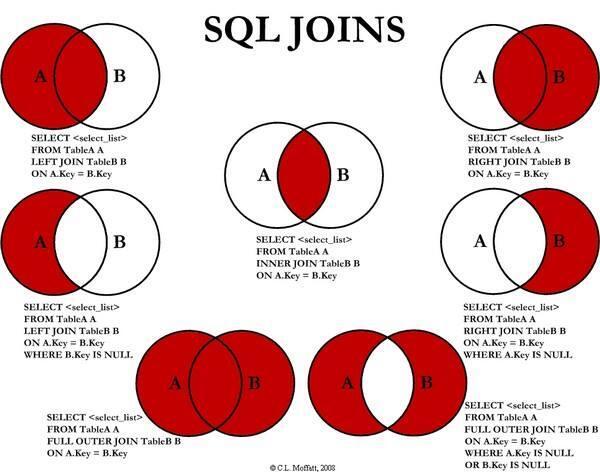由于 SQL Join 似乎被默认为基础,同时利用 ‘文氏图表’ 解释它,乍一看似乎是很自然的选择。然而,就像文章下面说的,我也发现在实际测试中,文氏图并没有完全符合SQL Join 语法。
通过图文并茂的方式对SQL的Join进行简单的介绍:join大致分为以下七种情况:
1准备数据
- DROP TABLE [dbo].[test_a]
- GO
- CREATE TABLE [dbo].[test_a] (
- [id] int NULL ,
- [name] varchar(255) NULL
- )
- GO
- -- ----------------------------
- -- Records of test_a
- -- ----------------------------
- INSERT INTO [dbo].[test_a] ([id], [name]) VALUES (N'1', N'苹果')
- GO
- GO
- INSERT INTO [dbo].[test_a] ([id], [name]) VALUES (N'2', N'橘子')
- GO
- GO
- INSERT INTO [dbo].[test_a] ([id], [name]) VALUES (N'3', N'菠萝')
- GO
- GO
- INSERT INTO [dbo].[test_a] ([id], [name]) VALUES (N'4', N'香蕉')
- GO
- GO
- INSERT INTO [dbo].[test_a] ([id], [name]) VALUES (N'5', N'西瓜')
- GO
- GO
- -----------------------------------------------------------
- DROP TABLE [dbo].[test_b]
- GO
- CREATE TABLE [dbo].[test_b] (
- [id] int NULL ,
- [name] varchar(255) NULL
- )
- GO
- -- ----------------------------
- -- Records of test_b
- -- ----------------------------
- INSERT INTO [dbo].[test_b] ([id], [name]) VALUES (N'1', N'梨子')
- GO
- GO
- INSERT INTO [dbo].[test_b] ([id], [name]) VALUES (N'2', N'苹果')
- GO
- GO
- INSERT INTO [dbo].[test_b] ([id], [name]) VALUES (N'3', N'草莓')
- GO
- GO
- INSERT INTO [dbo].[test_b] ([id], [name]) VALUES (N'4', N'桃子')
- GO
- GO
- INSERT INTO [dbo].[test_b] ([id], [name]) VALUES (N'5', N'香蕉')
- GO
- GO
2示例介绍
A.Inner join
产生A和B的交集。
- SELECT
- *
- FROM
- test_a
- INNER JOIN test_b ON test_a.name = test_b.name

B. Full outer join
产生A和B的并集。对于没有匹配的记录,则以null做为值。
- SELECT
- *
- FROM
- test_a
- FULL OUTER JOIN test_b ON test_a.name = test_b.name

C.Left outer join
产生表A的完全集,而B表中匹配的则有值,没匹配的以null值取代。
- SELECT
- *
- FROM
- test_a
- LEFT OUTER JOIN test_b ON test_a.name = test_b.name

D. Left outer join on where
产生在A表中有而在B表中没有的集合。
- SELECT
- *
- FROM
- test_a
- LEFT OUTER JOIN test_b ON test_a.name = test_b.name
- WHERE
- test_b.name IS NULL

E. RIGHT OUTER JOIN
产生表B的完全集,而A表中匹配的则有值,没匹配的以null值取代。
- SELECT
- *
- FROM
- test_a
- RIGHT OUTER JOIN test_b ON test_a.name = test_b.name

F. right outer join on where
产生在B表中有而在A表中没有的集合。
- SELECT
- *
- FROM
- test_a
- RIGHT OUTER JOIN test_b ON test_a.name = test_b.name
- WHERE
- test_a.name IS NULL


